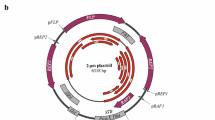Abstract
We studied illegitimate recombination by transforming yeast with a single-stranded (ss) non-replicative plasmid. Plasmid pCW12, containing the ARG4gene, was used for transformation of yeast strains deleted for the ARG4, either in native (circular) form or after linearization within the vector sequence by the restriction enzyme ScaI. Both circular and linearized ss plasmids were shown to be much more efficient in illegitimate integration than their double-stranded (ds) counterparts and more than two-thirds of the transformants analysed contained multiple tandem integrations of the plasmid. Pulsed-field gel electrophoresis of genomic DNA revealed significant changes in the karyotype of some transformants. Plasmid DNA was frequently detected on more than one chromosome and on mitotically unstable, autonomously replicating elements. Our results show that the introduction of nonhomologous ss DNA into yeast cells can lead to different types of alterations in the yeast genome.
Similar content being viewed by others
Author information
Authors and Affiliations
Additional information
Received: 9 February 1996/Accepted: 7 July 1996
Rights and permissions
About this article
Cite this article
Gjurac˘ić, K., Zgaga, Z. Illegitimate integration of single-stranded DNA in Saccharomyces cerevisiae . Mol Gen Genet 253, 173–181 (1996). https://doi.org/10.1007/s004380050310
Issue Date:
DOI: https://doi.org/10.1007/s004380050310




